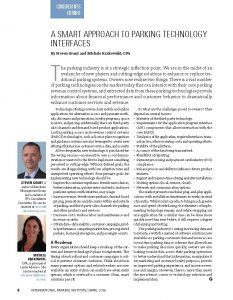By Steven Grant and Michele Krakowski
The parking industry is at a strategic inflection point. We are in the midst of an avalanche of new players and cutting-edge solutions to enhance or replace traditional parking systems. Owners now realize two things: There is a vast number of parking technologies on the market today that can interact with their core parking revenue control systems, and extracted data from these parking technologies provide information about financial performance and customer behavior to dramatically enhance customer services and revenue.
Technology offerings now include mobile and online applications for alternative access and payment methods, discounts and promotions, loyalty programs, space locators, and pricing. Additionally, there are third-party sales channels and demand-based product applications. Lastly, parking access and revenue control systems (PARCS) technologies, such as license plate recognition and guidance systems are also leveraged to create new offerings that increase customer service, data, and security.
All too frequently, new technology is purchased for the wrong reasons—an executive sees a cool demonstration or wants to be the first to implement something perceived as cutting-edge. Without defined goals, the results are disappointing, with low adoption rates and unexpected operating efforts. Four primary goals for implementing new technology should be:
- Improve the customer experience. Provide more choices, better information, quicker entry and exits, and more
payment options with intuitive, easy usage. - Increase revenue. Provide more products, demand-based pricing, promotions and discounts within and outside of parking, and third-party sales channels for parking and other products and services.
- Decrease costs. Reduce labor and maintenance and increase security.
- Obtain data—data analytics, customer campaigns, product performance, competing market data, pre-registered parkers, license plate regions, and passenger counts.
A Roadmap
Every organization should keep a roadmap of the current and future technology it plans to implement. The timing of each rollout and customer campaigns is critical to prevent customer confusion. Think about how many payment options and related readers are now available. An entry station can easily have seven entry options, which is overload to a customer. Clean, smart
solutions pay off.
- So what are the challenges posed to owners? They depend on several factors:
- Maturity of the third-party technology.
- Requirements for the application program interface (API) components that allow interaction with the core PARCS.
- Total price of the application, required interfaces, transaction fees, other recurring costs, and operating efforts.
- Stability of the platform.
- Accuracy of the data being transmitted.
- Flexibility of reporting.
- Payment processing and payment card industry (PCI) compliance.
- Release process and ability to influence future product features.
- Support and response times during and after installation.
- Hosting options (local, remote, cloud).
- Network and communication options.
The market promotes modular, plug-and-play applications with installation timeframes in weeks instead of months. While today’s products bring much greater ease and speed of interfacing, the elements of implementing technology remain. And while swapping out one application for a similar one can be done more quickly now than ever before, it still requires a degree of planning and testing.
The parking industry is seeing increasing demand to interface with the myriad of software solutions now available. As parking customers demand more access to real-time parking data or software that allows them to make parking decisions quickly, owners are also looking to mine data across their parking operations to better understand that information, manipulate it for marketing and customer loyalty purposes, provide an improved parking experience, and increase revenue and margin. However, there is more than meets the eye when it comes to technology selection and implementation.
Steven Grant is owner of Aberdeen Management Group and a member of IPI’s Consultants Committee. He can be reached at steven@aberdeenmg.com.
Michele Krakowski, CPA, is principal of Lumin Advisors. She can be reached at mkrakowski@lumin.us.com.
TPP-2016-04-A Smart Approach to Parking Technology Interfaces
